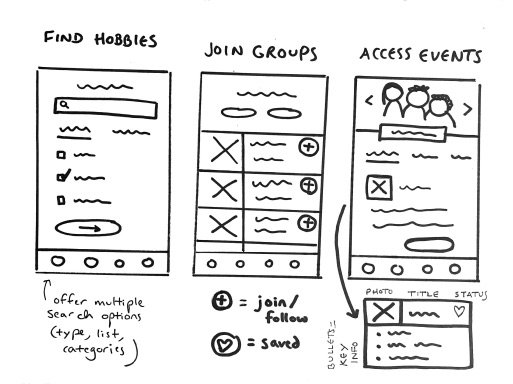Thinking about Design Thinking
For new designers, it’s so easy to want to just create and think about the process later.
But often for businesses and other large-scale projects, it’s important to instead utilize design thinking.
Design Thinking is a circular process of empathizing with your audience, defining a problem, creating ideas, making prototypes, and finally testing them, and repeating this until something sticks.
I’ll dive more into the different steps of the process, and how each sets designers up for creating products that work for everyone.
1. Empathize
The first stage in this process is actually getting to know your audience. Before designers can go out and make whatever they want, they need to understand what they are trying to solve, and the people that are going to be experiencing the project.
Rikke Friis Dam of the Interaction Design Foundation discusses this further, saying that “Empathy is crucial to problem-solving and a human-centered design process as it allows design thinkers to set aside their own assumptions about the world and gain real insight into users and their needs” (Friis Dam).
You can think about this from a personal perspective as well, as when you want to help someone with a problem, you don’t immediately start jumping to solutions, you listen to what is happening, and how that problem affects the person. From there you can more easily understand what is going on and how your efforts can possibly fix it.
2. Define
Once you have an idea of what is happening, you can now more clearly define the problems you identified. Here you are able to decide what exactly you are trying to address, using the perspectives you gained from the previous phase.
Again this relates heavily to the process for traditional problems, by first understanding what is happening and then determining what the actual problem is.
Rikke Friis Dam continues, saying “The Define stage will help the design team collect great ideas to establish features, functions, and other elements to solve the problem at hand—or, at the very least, allow real users to resolve issues themselves with minimal difficulty.” With that comes the next stage, Ideate.
3. Ideate
The Ideate stage is where designers often want to skip right off the bat, creating ideas and possible solutions to our previously defined problem. We can see now how important our research is to understanding the situation, as with the previous two stages down, we can now create solutions that best fit the problems users are facing.
Fast Company describes this ideation process, saying “Design thinking requires that no matter how obvious the solution may seem, many solutions be created for consideration. And created in a way that allows them to be judged equally as possible answers. Looking at a problem from more than one perspective always yields richer results.”
From there, the ideas with the most potential can be brought forward to the prototype stage, where they can be more fully developed.
4. Prototype
Within this phase, designers are able to take their favorite ideas forward and start making prototypes of the solution. These can range in many ways, being just a wireframe of what it is expected to be, or creating multiple aspects to fully show the scale of the idea.
Rikke Friis Dam again mentions the importance of this phase, saying “This is an experimental phase, and the aim is to identify the best possible solution for each of the problems identified during the first three stages. The solutions are implemented within the prototypes and, one by one, they are investigated and then accepted, improved, or rejected based on the users’ experiences.”
With these prototypes made, they can then be more thoroughly tested to see their limitations within the final stage of the design thinking process.
5. Test
Doing testing is the final stage of the process, and where problems are found within the initial prototypes created. This step is essential as testing is how we see how people use the prototype, where their eyes go, what they want to use, what they want to change, and more.
Once feedback is collected, designers can go back to the prototype phase to further fix their designs until they solve all the problems set out in the defined stage.
Sometimes this stage also reveals problems within the other stages of the process, where you need to go back to the ideation phase or even the define phase to better understand the problem and how it could potentially be solved.
Design thinking stands as an essential way to create intuitive experiences for users, allowing us to take an inside look into how people think, and how we can best design around them.
Dam, R. F. (2023, September 3). The 5 stages in the design thinking process. The Interaction Design Foundation. https://www.interaction-design.org/literature/article/5-stages-in-the-design-thinking-process
FAST COMPANY STAFF. (n.d.). What is design thinking and why is it popular? - fast company. Fast Company. https://www.fastcompany.com/919258/design-thinking-what
S, K. (2022, December 16). The design thinking process - how does it work? - maqe - insights. MAQE. https://www.maqe.com/insight/the-design-thinking-process-how-does-it-work/



